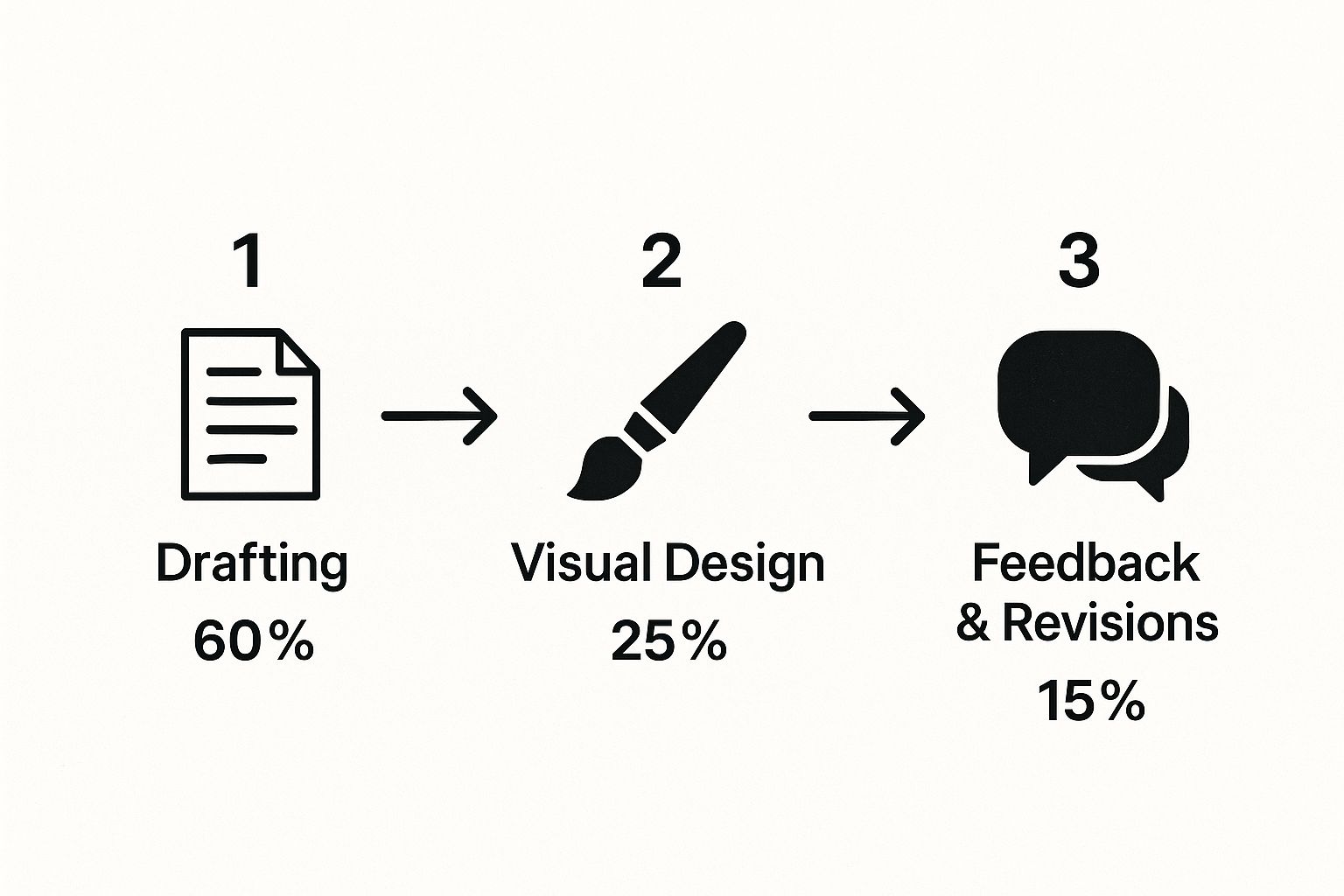A Modern Content Creation Workflow Guide

Let’s talk about your content creation workflow. In simple terms, it's your team's repeatable playbook for getting content from a rough idea to a published piece that gets real results. It’s the system that turns the usual chaos of deadlines and revisions into a smooth, predictable process. When you get this right, you unlock consistent quality and a sustainable output, which is the secret to scaling your content marketing without burning out.
Why a Documented Workflow Is Your Biggest Asset

If your content production feels more reactive than strategic, you're not alone. Most teams are constantly wrestling with missed deadlines, wildly inconsistent quality, and a general sense of barely keeping their heads above water. This guide isn't about creating rigid, soul-crushing rules. It’s about building a flexible content creation workflow that actually supports creativity and drives efficiency.
Honestly, a documented process is the single best investment you can make for your team's sanity and your company's long-term growth. It's how you finally break free from the content hamster wheel and start producing work that generates predictable results. Whether you're a one-person show or running a large marketing department, a clear process eliminates the guesswork, freeing up your brainpower for the work that truly matters: creating amazing content.
It's More Than Just a Checklist
I've seen so many teams mistake a simple to-do list for a workflow. They're not the same. A real workflow goes much deeper—it clearly defines roles, tools, timelines, and the critical handoffs between each stage of the process. It's the difference between vaguely asking someone to "write a blog post" and handing them a detailed brief, outlining a clear review cycle, and having a distribution plan ready to go. That level of clarity is what prevents bottlenecks and saves everyone from endless frustration.
The data backs this up. Research shows that a shocking number of marketing strategies underperform simply because they aren't written down. In fact, only 29% of marketers with a documented strategy rate their efforts as highly effective. The most common pitfalls? A lack of clear goals (42%), content that doesn't align with the customer journey (39%), and not using data to make decisions (35%). You can explore more insights on content marketing statistics from the Content Marketing Institute to see the full picture.
A great workflow doesn't stifle creativity; it builds a container for it. When your team isn't worried about how to get things done, they can focus on doing their best work.
The Real-World Benefits
Putting a structured system in place isn't just a neat organizational exercise. It has a direct, measurable impact on your business and your team's well-being. Here’s a look at what you can expect:
- Improved Efficiency: Stop wasting time by making it crystal clear who does what and when.
- Consistent Quality: Every single piece of content meets your brand and SEO standards before it ever sees the light of day.
- Easier Scalability: Onboard new writers, editors, or designers in a fraction of the time and ramp up your content output without things falling apart.
- Reduced Burnout: Fewer last-minute scrambles and communication black holes lead to a happier, more focused, and more productive team.
Building Your Idea and Planning Engine

Every piece of truly exceptional content starts with a brilliant idea. This initial stage is where you lay the groundwork, and it’s about so much more than just pulling together a list of keywords. A solid content creation workflow begins by systematically figuring out what your audience genuinely needs and then strategically mapping out how to give it to them.
To get this right, you have to look past the usual SEO tools and start listening to the conversations already happening all around your business. You’d be surprised—your customer-facing teams are sitting on a goldmine of content ideas.
Uncovering Hidden Content Opportunities
Often, your very best ideas come straight from your audience. They're telling you exactly what they want to learn; you just need to know where to tune in.
Start by treating your customer support tickets and sales call notes as a primary source for inspiration. What questions pop up over and over? What pain points are mentioned in nearly every demo? These are the real-world problems your audience is actively trying to solve.
Another powerful tactic is a competitor gap analysis. But this isn't about just checking which keywords your rivals are ranking for. Instead, your goal is to pinpoint the topics they've covered poorly or missed altogether. Look for the "what's next?" questions their content fails to answer. Those gaps are prime real estate where you can step in and become the definitive resource.
From a Long List to a Smart Backlog
Once the ideas start flowing in, the real challenge becomes prioritization. Let's be honest, not all ideas are created equal, and trying to chase every single one is a fast track to burnout. This is where a simple scoring model can bring much-needed clarity to your content strategy.
I recommend creating a simple spreadsheet to score each idea on a scale of 1-5 across a few key criteria. This small step helps turn a subjective brainstorming session into an objective plan, making sure you’re always working on the highest-impact topics first.
- SEO Potential: What's the search volume like? How realistic is it for us to rank in the top spots? A high score here points to significant organic traffic potential.
- Audience Need: Does this idea solve a real, burning problem for our ideal customer? A high score means the content will resonate deeply and build trust.
- Business Alignment: How closely does this topic connect to our products or services? A high score means it’s more likely to attract qualified leads and support sales.
Just add up the scores. The ideas with the highest totals should move to the top of your list. This straightforward system keeps your content plan perfectly balanced between what your audience wants to read and what your business needs to achieve.
A great idea without a great brief is just a guess. The brief is your blueprint; it turns a concept into a clear, actionable plan that aligns your entire team and drastically reduces the need for revisions.
Crafting the Perfect Content Brief
With your top-priority ideas selected, the final step in this planning phase is to create a detailed content brief. I can't overstate this: a solid brief is the single most important tool for preventing the endless, frustrating revision cycles that plague so many content teams.
A comprehensive brief becomes the single source of truth for the entire team—from the writer and designer to the editor and SEO specialist. It guarantees everyone is on the same page from day one.
While it can be a living document, a truly effective brief needs to include several core components:
- Target Audience: Go deeper than basic demographics. Describe their specific pain points, what they likely already know, and how you want them to feel after consuming the content.
- Primary & Secondary Keywords: Be specific. List the exact terms you're targeting to keep the SEO focus sharp.
- Core Angle: What's our unique take on this topic? Are we debunking a common myth, offering a detailed tutorial, or presenting a controversial new perspective?
- Key Talking Points: Outline the essential arguments, data, or steps that must be included. This isn't a full outline, but rather a list of non-negotiable elements.
- Call-to-Action (CTA): What is the one primary action you want the reader to take when they're done?
Putting in this work upfront—in planning and briefing—is what separates a chaotic, reactive content process from a high-functioning content creation workflow. It creates the structure that gives your team’s creativity the freedom to truly shine.
Turning Brilliant Ideas Into Polished Content
So, you have a solid brief in your hands. Now comes the exciting part: turning that abstract plan into a real, tangible piece of content. This is where your content creation workflow truly shifts into gear, moving from concept to a polished, publishable asset. Keeping the momentum going and making sure everyone works together smoothly is the name of the game here.
This isn't just about a writer disappearing into a cave and emerging with a finished draft. It’s more like a carefully choreographed dance. You've got the writer weaving the story, the designer bringing it to life with visuals, the SEO specialist making sure people can find it, and a subject matter expert giving it the stamp of authority. Each person plays a crucial part.
Think about creating a big, comprehensive guide. In a project management tool like Trello or Asana, that main "Guide" card would be the parent task. Underneath it, you'd have smaller, specific sub-tasks for each team member, all with their own deadlines and dependencies clearly marked.
Orchestrating the Creative Process
Great collaboration doesn't just happen; you have to design it. The first order of business is defining who owns what. I’ve seen more content get stuck in limbo because of fuzzy responsibilities than for any other reason. The piece just sits there, waiting for feedback or a missing graphic, because no one knows whose court the ball is in.
To sidestep this common bottleneck, map out everyone's role right inside your project management system. For instance, the writer’s task isn’t truly "done" until the SEO specialist has reviewed it for keyword optimization and internal linking opportunities. This simple step creates a natural handoff and a sense of shared ownership.
And let's be real, the pressure is on. The creator economy has absolutely exploded, with over 165 million new creators flooding social platforms since 2020. With that kind of fierce competition, your content has to be exceptional just to get noticed. A well-oiled workflow is what lets you produce that high-quality work again and again, without burning out your team. You can find out more about how the creator economy is evolving on spiralytics.com.
A smart process doesn't just deliver a great final product—it also plants seeds for the future. As you're creating, keep an eye out for interesting stats, powerful quotes, or sharp graphics that could be pulled out and used elsewhere. To get a head start, you can check out our guide on content repurposing strategies for some great ideas on squeezing every last drop of value from your work.
To make collaboration crystal clear, it helps to formally define who is responsible for what. The table below outlines a typical structure for the content creation phase, ensuring everyone knows their part.
Role-Based Responsibilities in the Content Creation Phase
| Role | Primary Responsibility | Key Tool(s) | Success Metric |
|---|---|---|---|
| Writer / Content Creator | Draft the initial content based on the brief, incorporating the primary narrative and core messaging. | Google Docs, Word, GrowChief | First draft completed on time and aligned with the brief's objectives. |
| SEO Specialist | Review the draft for keyword optimization, internal/external linking, and on-page SEO best practices. | Ahrefs, Semrush, Google Search Console | SEO score improvement; alignment with target keyword intent. |
| Graphic Designer | Create all necessary visuals, including infographics, custom images, and social media graphics. | Canva, Adobe Creative Suite | Visuals are brand-aligned, enhance the content, and are delivered by the deadline. |
| Subject Matter Expert (SME) | Verify the factual accuracy, technical correctness, and overall authority of the content. | N/A (Review in-doc) | Content is validated as accurate and credible, with minimal factual errors. |
Having this kind of clarity eliminates confusion and empowers each team member to take ownership of their contribution, leading to a much smoother and faster creation cycle.
Allocating Your Time for Maximum Impact
Finding the right balance between speed and quality means getting real about where your team's time is actually going. Every project is unique, of course, but having a general breakdown helps you manage expectations and plan your resources far more effectively.
This visual shows a pretty standard time allocation for getting from a brief to a final draft, focusing on the main creation activities.

As you can see, the heavy lifting happens during the initial drafting phase. But what’s often underestimated is the significant chunk of time needed for good design and thoughtful revisions. You have to account for that.
This proves that "creation" is so much more than just writing. It’s a layered process that demands dedicated time for visual storytelling and collaborative fine-tuning. When you build this reality into your timeline from day one, you avoid those frantic, last-minute scrambles and ensure every part of the content gets the attention it needs to shine.
A project management tool isn't just for ticking off tasks. It should be your team's central communication hub. Use comments to ask questions, tag people for specific feedback, and attach all relevant files. Keep everything in one organized, accessible place.
The Role of Clear Communication
Even with the best tools and a perfect process map, your workflow will grind to a halt without clear, direct communication. It’s vital to foster a culture where feedback is specific, constructive, and always tied back to the goals you all agreed on in the content brief.
For example, a designer shouldn't just say, "I don't like this image." That helps no one. Instead, they should give actionable feedback: "This stock photo feels a little too generic. Let’s find an image that better captures the innovative angle we're going for in the text."
The same goes for a subject matter expert. "This section is wrong," is a dead end. What moves the project forward is, "This part is a bit misleading. A more accurate way to phrase it would be…" This level of specific, goal-focused feedback is what transforms a decent draft into a truly great piece of content.
Weaving AI into Your Workflow

AI is no longer just a buzzword—it's a practical tool that can give your content creation workflow a serious boost. The trick is to stop thinking of it as a replacement for your team's creativity. Instead, think of it as a very capable assistant, ready to handle the grunt work so your team can focus on strategy and storytelling.
This isn’t about hitting a button and having a robot write your next article. It's about strategically plugging AI into specific stages of your process. When you get this right, you can speed up research, build stronger outlines, and get polished drafts out the door much, much faster.
Using AI as Your Research Partner
Let's start right at the beginning: the blank page. Instead of just brainstorming into the void, you can use AI as a brilliant research and ideation partner. The key is to treat it like a new team member and give it clear instructions with plenty of context.
For example, a vague prompt like "Give me blog ideas" will get you vague, useless results. But get specific, and the game changes completely.
Actionable Prompt Example:
"You are a content strategist for a B2B SaaS company that sells project management software to marketing agencies. Our target audience is marketing managers who are struggling with disorganized projects and missed deadlines. Generate 10 blog post ideas that address their biggest pain points. For each idea, provide a compelling title, a one-sentence summary, and the primary keyword to target."
This is the kind of detail that separates generic noise from a list of genuinely viable topics. You're giving the AI guardrails, ensuring its suggestions are perfectly aligned with your audience and your business.
Speeding Up the First Draft
Once you’ve locked in a solid idea, AI can be a huge help in building the skeleton of your article. It’s fantastic at taking a big, complex topic and breaking it down into a logical flow with clear headings and subheadings.
This isn't just a niche trick anymore; it's becoming standard practice. Projections show that by 2025, nearly 90% of content marketers will be using AI. The most common applications are for foundational tasks like creating content outlines (71.7%) and brainstorming (68%). If you want to dig deeper into the numbers, Siege Media has some great data on content marketing trends.
For instance, this is exactly how a tool like GrowChief can help you get started, generating relevant and engaging post ideas right inside the platform.

As you can see, you can pop in a topic and let the AI propose different angles. This saves a ton of time and keeps your content calendar from running dry.
The Human Touch is Still Non-Negotiable
Here’s the most important rule: while AI is an amazing assistant, it absolutely cannot replace human insight, empathy, or your brand's voice. The final piece must always be shaped and polished by a person.
Here’s where human oversight is absolutely essential:
- Fact-Checking: AI tools are notorious for "hallucinating" or just making things up. Every single statistic, claim, or fact it generates must be double-checked by a human against a credible source. No exceptions.
- Brand Voice and Tone: An AI has no idea what makes your brand sound like you. Your writers and editors must be the ones to inject the personality, humor, and unique perspective that your audience expects.
- Unique Insights and Stories: Your team's real-world experience, customer anecdotes, and original analysis are your secret sauce. AI can't invent these things; it can only help structure the information you feed it.
Think of AI as your raw material supplier. It can deliver a neat pile of bricks, but it's the human creator who has to be the architect, building something meaningful and unique out of those parts.
Platforms like GrowChief bring this partnership to life by supporting multiple stages of the content process. For example, it can automate social media engagement by replying to posts on specific topics, helping get your content seen and sparking conversations. That kind of automation frees you up to focus on creating your next great piece. To make the most of it, you'll want to have a solid grasp of the key social media engagement metrics that a tool like GrowChief can help you influence.
Ultimately, a successful AI-assisted content creation workflow is a true collaboration. You delegate the repetitive, data-heavy tasks to the machine, which in turn empowers your human creators to do what they do best: think critically, tell great stories, and connect with your audience.
Designing a Review Process That Doesn't Grind You to a Halt
Let's be honest: the review and approval stage is where great content workflows often go to die. It's a classic bottleneck. You absolutely need quality control, but when it turns into an endless cycle of conflicting feedback and revisions, it just kills momentum and morale.
The biggest mistake I see teams make is a "feedback free-for-all." They send a draft to everyone at once—the editor, the SEO specialist, the department head—and hope for the best. What they get back is a mess of contradictory notes, leading to frustrating rewrites. The solution isn't to skip the checks; it's to create a smarter, more structured process.
Stop the Chaos with a Tiered Review System
Think of your review process less like a group discussion and more like a series of checkpoints. A piece of content can't advance to the next stage until it has passed the current one. This simple structure prevents a final stakeholder from commenting on keyword density when the draft hasn't even been spell-checked yet.
Here’s how you can break it down:
-
The Buddy Check (Peer Review): This is the first, most informal pass. The writer simply asks a fellow writer or a trusted teammate to give it a quick read. The goal here isn't a deep strategic dive; it's a gut check for clarity, flow, and basic sense. Does it read well? Is anything confusing?
-
The Polish & Optimize Pass (Editorial and SEO): Once the initial kinks are worked out, the draft goes to your editor and SEO specialist. The editor hones in on grammar, style, and brand voice. At the same time, the SEO pro can ensure all the on-page elements are dialed in—keywords are in the right places, internal links are solid, and the meta description is compelling.
-
The Expert Gut Check (SME Review): Now that the content is clean and optimized, it's time for your subject matter expert. Their only job is to verify factual and technical accuracy. Since they aren't getting bogged down by typos or awkward sentences, they can give their expert opinion quickly and efficiently.
-
The Final Green Light (Stakeholder Approval): This is the last stop on the train. This person might be a marketing director, a department head, or even someone from legal. Their role is to give the final sign-off, confirming the piece aligns with the bigger picture or meets compliance standards. By this point, there should be no major surprises.
When a piece of content reaches that final approver, it should be 95% of the way there. Their feedback becomes a final polish, not a mandate for a page-one rewrite.
The Power of a Pre-Flight Checklist
To make this tiered system truly sing, give your team a simple "pre-flight checklist." This is a quick quality control tool the creator uses before sending the content off for review. It encourages them to self-edit and catch the easy stuff first.
Keep it simple—a one-page document with your absolute non-negotiables.
- Brand Voice: Does the tone sound like us? (Refer to the style guide.)
- SEO Basics: Is the primary keyword in the title, H1, and intro?
- Readability: Are headings, lists, and bolding used to break up the text?
- Compliance: Are all sources properly cited? Are there any claims we can't back up?
A pre-flight checklist is a game-changer. It pushes the responsibility for basic quality back to the creator, freeing up your reviewers to be strategic partners instead of just proofreaders.
By clearly defining who does what and when, you create a feedback loop that's built for improvement, not frustration. This turns what is often the most painful part of the content creation workflow into something smooth, predictable, and genuinely collaborative.
Driving Performance After You Publish
Hitting “publish” doesn’t mean the job is done. Honestly, that’s when the real work begins. Your content is now out in the wild, and its success depends entirely on what you do next to help it find an audience, spark conversations, and ultimately, generate leads. A brilliant piece of content that no one ever sees is just a well-written file sitting on your server.
To make sure your effort pays off, your workflow needs a solid plan for distribution and performance tracking. This goes way beyond just sharing a link on Twitter and calling it a day. It’s about strategically placing your content in front of the right eyeballs and then listening carefully to what the data tells you.
Creating Your Multi-Channel Distribution Plan
A smart distribution strategy means looking past your own social media feeds. You have to proactively get your content into the places where your ideal audience is already hanging out.
The easiest place to start is with your owned channels—the platforms you control completely. Your email newsletter is arguably your most valuable asset here. Don't just blast out a link. Instead, frame the content with a compelling story or a powerful takeaway that genuinely piques your subscribers' interest and makes them want to click. It's your direct line to your most loyal followers.
From there, it's time to explore earned channels. This is all about strategic outreach to communities where your content can add real value.
- Community Engagement: Pinpoint relevant groups on places like LinkedIn, Facebook, or even specific subreddits. The trick is to be a member, not a marketer. Participate in conversations, offer help, and only share your content when it’s a direct and useful answer to someone’s question. This approach builds incredible credibility and drives high-intent traffic back to your site.
- Strategic Syndication: Keep an eye out for non-competing blogs or online publications that cater to a similar audience. Pitching your article for syndication can introduce it to a huge new readership. Most will include a canonical link back to your original post, which is fantastic for your SEO.
Juggling all those conversations across different platforms requires a clear strategy. To get a handle on it, you can learn about social media community management and turn those interactions into real growth.
Measuring What Truly Matters
Once your content is out there and circulating, the next step is to figure out if it's actually working. It’s easy to get lost in a sea of data, so the key is to focus on the key performance indicators (KPIs) that directly reflect the goals you set in the beginning.
Forget about vanity metrics like total page views. Instead, build a simple, clean dashboard in a tool like Google Analytics that tracks what's actually moving the needle for your business. This dashboard should give you a clear, immediate snapshot of your content's health.
Essential KPIs for Your Dashboard:
- Organic Traffic & Keyword Rankings: How many people are finding your content from a search? Are you moving up in the rankings for your target keywords? This is the most reliable indicator of long-term SEO value.
- Backlinks Acquired: Are other websites linking to your content as a resource? You can track this with tools like Ahrefs or Semrush. Every quality backlink acts as a vote of confidence, boosting your site's authority.
- User Engagement Metrics: Dig deeper than views. Metrics like average time on page and scroll depth reveal whether people are actually reading what you wrote. A high bounce rate or low time on page might mean your headline is writing checks your content can't cash.
- Conversion Rate: This is the bottom line. How many readers are taking the action you wanted them to? Whether it’s signing up for a webinar, downloading an asset, or booking a demo, you need to track this by setting up goals in Google Analytics.
Your data isn't just a report card; it's a roadmap. Every metric, whether good or bad, is a piece of feedback that tells you what your audience wants more of—and what they don't.
Closing the Loop and Getting Smarter
This final piece of the puzzle is what turns a simple process into a powerful cycle of continuous improvement. Everything you learn from your performance analysis should feed directly back into the very first stage of your content creation workflow: ideation and planning.
Did a deep-dive post on a niche topic bring in a surprising number of high-quality leads? That's your cue to explore that topic further. Did a massive guide get tons of traffic but almost zero conversions? Perhaps the call-to-action was off, or it attracted an audience that wasn't a good fit.
This feedback loop is what makes your content engine smarter over time. You stop making guesses and start making decisions based on cold, hard data. Your successes show you where to double down, and your misses offer priceless lessons on what to change next time. This agile mindset ensures your workflow isn't a rigid checklist but a living system that evolves with every piece of content you ship.
Ready to amplify your content’s reach without spending hours on social media? GrowChief acts as your AI-powered engagement agent, automatically interacting with relevant conversations to get your content seen by the right people. Start your seven-day free trial of GrowChief and see how automated engagement can supercharge your workflow.





